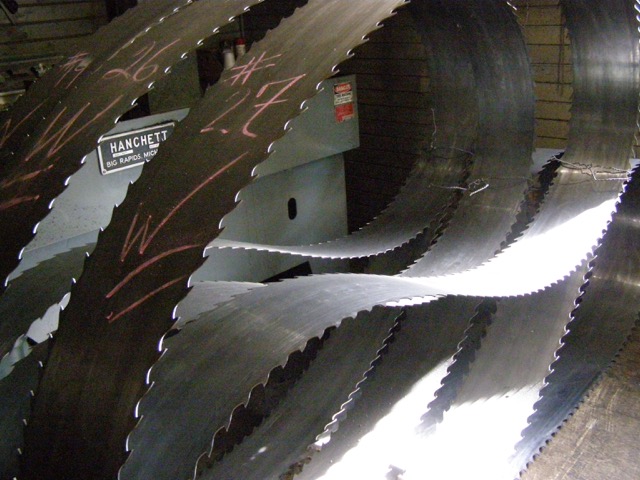Sourcing Local Wood

Blog by Julia Tate, photos courtesy of Lee Burnett
Waking up to the rich smell of pine reminds me that it’s not going to be an ordinary day at the office. My first journey to the serene shores of Millinocket Lake, with Mount Katahdin looming in the background has been an educational one as a design professional learning about sourcing local wood in Maine.
On an action packed, two-day Fall tour organized by Local Wood Works, along with five other designers and engineers, I visit local saw mills and feel the soft, pine needle floor beneath my feet while walking through Public Reserve land, learning about best practices from state foresters keenly in tune with each tree stand. In just a few mesmerizing minutes, tall trees are deftly felled and processed with equipment twice my height a few dozen yards away as best sourcing practices and current challenges to the industry are outlined by land managers responsible for distributing millions of board feet of Maine wood each year. We visit shops of manufacturers both on and off the beaten path, and round out the trip with a discussion led by Lloyd Irland, and Ken Laustsen on wood markets, biometrics, and tips on local sourcing alternatives for commonly specified items.
It’s an eye-opening illustration of the network behind the growing brand of Maine Wood, and further how the industry reaches beyond our local economy to the broader globe, and sometimes back again. As an architect, it’s an incredible glimpse behind the curtain not just at the products we might be able to specify, but how those decisions can help build connections to the industry behind them. It’s an opportunity to celebrate and also be strengthened by the collective knowledge and efforts of the various roles that are critical to what is being referred to as the new ‘forest to table’ movement.

Make An Early Commitment
Specifying local wood is becoming increasingly easier as efforts by groups like Local Wood Works to create product directories and local wood boiler plate specifications for both residential and commercial construction make headway. The most critical thing a designer or engineer can do regardless of the size or type of project is make the commitment to use local wood in a project and get the owner on-board early in the design process. Numerous local wood species are available in the state of Maine that can be used for everything from structurally graded lumber to finishing materials to heating fuel: white ash, red maple, hemlock, oak, white pine, and cedar are some of the most commonly found. Thanks to the work of the University of Maine Composites Center in Orono, Norway Spruce was approved and recognized by the ALSC (American Lumber Standards Committee) and NeLMA (Northeastern Lumber Manufacturers Association) in 2016 as a graded construction material. And with the widespread availability of portable saw mills and sawyers, owners who are lucky enough to have their own tree stands on-site may have the option of having a NeLMA certifier come to them for a relatively nominal fee.
Challenges
There are inherent limitations. Self-certification may require more intensive communications with local officials, and of course requires the right specimen. And of course, every project is governed by the dreaded triangle of time-cost and quality. The time to research the local materials and sources, and sometimes the added expense, will not be possible on every project using wood. Depending on the project type and size, certifications and supply chains may also be a limitation. While there is plenty of SFI, FSC and SCS certified timber in Maine, and there are foresters that do meticulously track chain of custody, some manufacturers have said that generally adopted current processes are somewhat onerous and difficult for them to trace in volume. Often, local wood will not mean certified wood, so depending on project contract requirements, this well-intentioned requirement is sometimes a roadblock and should be decided early.
There are exciting things happening in our wood industry, but it’s also adapting to deal with overarching challenges such as labor shortages, insect infestations and global warming. At each wood conference I attend, I am amazed at the interest, collaboration, and sheer bench strength of the wood industry and its supporters in this state and beyond. Stay tuned for more to come. Below are links to the directory and spec resources mentioned above.
Local Resources
https://www.localwoodworks.org/products/
https://mailchi.mp/e78abb184a76/lwwspec



